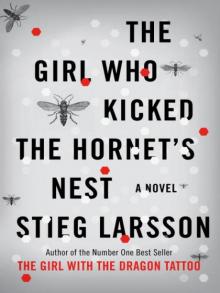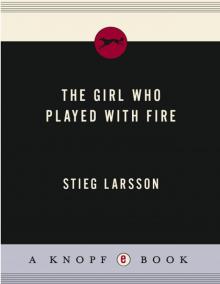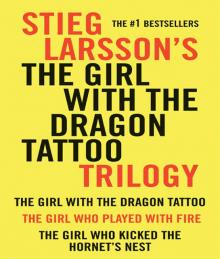- Home
- Stieg Larsson
Millennium 02 - The Girl Who Played with Fire Page 41
Millennium 02 - The Girl Who Played with Fire Read online
Page 41
“Was Lisbeth Salander a member of Evil Fingers?”
“I wouldn’t think so.”
“What is that supposed to mean?”
“Lisbeth is probably the most tone-deaf person I’ve ever met.”
“Tone-deaf?”
“She can tell the difference between trumpet and drums, but that’s about as far as her musical talent stretches.”
“I mean, was she in the group Evil Fingers?”
“And I just answered your question. What the hell do you think Evil Fingers is?”
“You tell me.”
“You’re running a police investigation by reading idiotic newspaper articles.”
“Answer the question.”
“Evil Fingers was a rock band. We were a bunch of girls in the mid-nineties who liked hard rock and played for fun. We promoted ourselves with a pentagram and a little ‘Sympathy for the Devil.’ Then the band broke up, and I’m the only one who’s still working in music.”
“And Lisbeth Salander was not, you say, a member of the band?”
“Like I said.”
“So why do our sources claim that Salander was in the band?”
“Because your sources are about as stupid as the newspapers.”
“Explain.”
“There were five of us girls in the band, and we still get together now and then. In the old days we used to meet once a week at Kvarnen. Now it’s about once a month. But we stay in touch.”
“And what do you do when you get together?”
“What do you think people do at Kvarnen?”
Faste sighed. “So you get together to drink.”
“We usually drink beer. And we gossip. What do you do when you get together with your friends?”
“And how does Salander come into the picture?”
“I met her at KomVux several years ago. She used to show up from time to time at Kvarnen and have a beer with us.”
“So Evil Fingers can’t be regarded as an organization?”
Norén looked at him as if he were from another planet.
“Are you dykes?”
“Would you like a punch in the mouth?”
“Answer the question.”
“It’s none of your business what we are.”
“Take it easy. You can’t provoke me.”
“Hello? The police are claiming that Lisbeth murdered three people and you come here to ask me about my sexual preferences. You can go to hell.”
“You know, I could take you in.”
“For what? By the way, I forgot to tell you that I’ve been studying law for three years and my father is Ulf Norén of Norén & Knape, the law firm. See you in court.”
“I thought you worked in the music business.”
“I do this because it’s fun. You think I make a living doing this?”
“I have no idea how you make a living.”
“I don’t make a living as a lesbian Satanist, if that’s what you think. And if that’s the basis of the police search for Lisbeth, then I can see why you haven’t found her.”
“Do you know where she is?”
Norén began rocking her upper body back and forth and let her hands glide up in front of her.
“I can feel that she’s close … Wait a minute, I’ll check my telepathic powers.”
“Cut it out.”
“I’ve already told you I haven’t heard from her for almost two years. I have no idea where she is. So now, if there isn’t anything else …”
Modig hooked up Svensson’s computer and spent the evening cataloguing the contents of his hard drive and the disks. She sat there until 11:00 reading his book.
She came to two realizations. First, that Svensson was a brilliant writer who described the business of the sex trade with compelling objectivity. She wished he could have lectured at the police academy—his knowledge would have been a valuable addition to the curriculum. Faste, for example, could have benefited from Svensson’s insights.
The second realization was that Blomkvist’s theory about Svensson’s research providing a motive for murder was completely valid. Svensson’s planned exposure of prostitutes’ clients would have done more than merely hurt a number of men. It was a brutal revelation. Some of the prominent players, several of whom had handed down verdicts in sex-crime trials or participated in the public debate, would be annihilated.
The problem was that even if a john who risked being exposed had decided to murder Svensson, there was, as yet, no prospect of such a link to Nils Bjurman. He did not feature in Svensson’s material, and that fact not only diminished the strength of Blomkvist’s argument but also reinforced the likelihood of Salander’s being the only possible suspect.
Even if a motive for the murders of Svensson and Johansson was still unclear, Salander had been at the crime scene and her fingerprints were on the murder weapon.
The weapon was also directly linked to the murder of Bjurman. There was a personal connection and a possible motive—the decoration on Bjurman’s abdomen raised the possibility of some form of sexual assault or a sadomasochistic relationship between the two. It was impossible to imagine Bjurman having voluntarily submitted to such a bizarre and painful tattoo. Either he had found pleasure in the humiliation or Salander—if she was the one who had done the tattooing—had first made him powerless. How it had actually happened was not something Modig wanted to speculate about.
On the other hand, Teleborian had confirmed that Salander’s violence was directed at people whom she regarded as a threat or who had offended her.
He had seemed genuinely protective, as if he did not want his former patient to come to any harm. All the same, the investigation had been based largely on his analysis of her—as a sociopath on the border of psychosis.
But Blomkvist’s theory was attractive.
She chewed her lower lip as she tried to visualize some alternative scenario to Salander the killer, working alone. Finally she wrote a line in her notebook.
Two completely separate motives? Two murderers? One murder weapon?
She had a fleeting thought that she could not quite pin down, but it was something she intended to ask Bublanski at the morning meeting. She could not explain why she suddenly felt so uncomfortable with the theory of Salander as a killer working alone.
Then she called it a night, resolutely shut down her computer, and locked the disks in her desk drawer. She put on her jacket, turned off the desk lamp, and was just about to lock the door to her office when she heard a sound further down the corridor. She frowned. She had thought she was alone in the department. She walked down the corridor to Faste’s office. His door was ajar and she heard him talking on the phone.
“It undeniably links things together,” she heard him say.
She stood undecided for a moment before she took a deep breath and knocked on the doorjamb. Faste looked up in surprise. She waved.
“Modig is still in the building,” Faste said into the phone. He listened and nodded without releasing her from his gaze. “OK, I’ll tell her.” He hung up. “Bubble,” he said in explanation. “What do you want?”
“What is it that links things together?” she asked.
He gave her a searching look. “Were you eavesdropping?”
“No, but your door was open and I heard you say that just as I knocked.”
Faste shrugged. “I called Bubble to tell him that the NFL have finally come up with something useful.”
“What’s that?”
“Svensson had a mobile with a Comviq cash card. They’ve produced a list of calls which confirms the conversation with Mikael Blomkvist at 7:30 p.m. That’s when Blomkvist was at dinner at his sister’s house.”
“Good. But I don’t think Blomkvist has anything to do with the murders.”
“Me neither. But Svensson made another call that night. At 9:34. The call lasted three minutes.”
“And?”
“He called Nils Bjurman’s home phone. In other words, there’s a link be
tween the two murders.”
Modig sank down into Faste’s visitor’s chair.
“Sure. Have a seat, be my guest.”
She ignored him.
“OK. What does the time frame look like? At 7:30 Svensson calls Blomkvist and sets up a meeting for later that evening. At 9:30 Svensson calls Bjurman. Just before closing time at 10:00 Salander buys cigarettes at the corner shop in Enskede. Soon after 11:00 Blomkvist and his sister arrive in Enskede and at 11:11 he calls the police.”
“That seems to be correct, Miss Marple.”
“But it isn’t correct at all. According to the pathologist, Bjurman was shot between 10:00 and 11:00 that night. By which time Salander was in Enskede. We’ve been working on the assumption that Salander shot Bjurman first and then the couple in Enskede.”
“That doesn’t mean a thing. I talked with the pathologist again. We didn’t find Bjurman until the night after, almost twenty-four hours later. The pathologist says that the time of death could be plus or minus an hour.”
“But Bjurman must have been the first victim, since we found the murder weapon in Enskede. That would mean that she shot Bjurman sometime after 9:34 and then drove to Enskede, where she bought her cigarettes. Was there enough time to get from Odenplan to Enskede?”
“Yes, there was. She didn’t take public transportation as we assumed earlier. She had a car. Sonny Bohman and I test-drove the route and we had plenty of time.”
“But then she waits for an hour before she shoots Svensson and Johansson? What was she doing all that time?”
“She had coffee with them. We have her prints on the cup.”
He gave her a triumphant look. Modig sighed and sat silently for a minute.
“Hans, you’re looking at this like it’s some sort of prestige thing. You can be a fucking shithead and you drive people crazy sometimes, but I actually knocked on your door to ask you to forgive me for slapping you. I was out of line.”
He looked at her for a long moment. “Modig, you might think I’m a shithead. But I think you’re unprofessional and don’t have any business being a police officer. At least not at this level.”
Modig weighed various replies, but in the end she just shrugged and stood up.
“Well, now we know where we stand.”
“We know where we stand. And believe me, you’re not going to last long here.”
Modig closed the door behind her harder than she meant to. Don’t let that fucking asshole get to you. She went down to the garage.
Faste smiled contentedly at the closed door.
Blomkvist had just gotten home when his mobile rang.
“Hi. It’s Malin. Can you talk?”
“Sure.”
“Something struck me yesterday.”
“Tell me.”
“I was going through all the clippings we have here on the hunt for Salander, and I found that spread on her time at the psychiatric clinic. What I’m wondering is why there’s such a big gap in her biography.”
“What gap?”
“There’s plenty of stuff about the trouble she was mixed up in at school. Trouble with teachers and classmates and so on.”
“I remember that. There was even a teacher who said she was afraid of Lisbeth when she was eleven.”
“Birgitta Miåås.”
“That’s the one.”
“And there are details about Lisbeth at the psychiatric clinic. Plus a lot of stuff about her with foster families during her teens and about the assault in Gamla Stan.”
“So what are you thinking?”
“She was taken into the clinic just before her thirteenth birthday.”
“Yes?”
“And there isn’t a word about why she was committed. Obviously if a twelve-year-old is committed, something has to have happened. And in Lisbeth’s case it was most likely some huge outburst that should have shown up in her biography. But there’s nothing there.”
Blomkvist frowned. “Malin, I have it from a source I trust that there’s a police report on Lisbeth dated March 1991, when she was twelve. It’s not in the file. I was at the point of asking you to dig around for it.”
“If there’s a report then it would have to be a part of her file. It would be breaking the law not to have it there. Have you really checked?”
“No, but my source says that it’s not in the file.”
Eriksson paused for a second. “And how reliable is your source?”
“Very.”
Eriksson and Blomkvist had arrived at the same conclusion simultaneously.
“Säpo,” Eriksson said.
“Björck,” Blomkvist said.
CHAPTER 24
Monday, April 4–Tuesday, April 5
Per-Åke Sandström, a freelance journalist in his late forties, came home just after midnight. He was a little drunk and felt a lump of panic lurking in his stomach. He had spent the day doing nothing. He was, quite simply, terrified.
It was almost two weeks since Svensson had been killed. Sandström had watched the TV news that night in shock. He had felt a wave of relief and hope—Svensson was dead, so maybe the book about trafficking, in which Sandström would be exposed, was history.
He hated Svensson. He had begged and pleaded, he had crawled for that fucking pig.
It was not until the day after that that he began to consider his situation. The police would find Svensson’s text and start digging into his little escapade. Jesus … he could even be a murder suspect.
His panic had subsided when Salander’s face was slapped on every front page in the country. Who the hell was this Salander? He had never heard her name before. But the police clearly considered her a serious suspect, and according to the prosecutor’s statement, the murders might soon be solved. It was possible that no-one would show any interest in him at all. But from his own experience he knew that journalists always saved documentation and notes. Millennium. A piece-of-shit magazine with an undeserved reputation. They were like all the rest. Poking around and whining and damaging people.
He had no way of knowing how long the research had been going on. There was nobody he could ask. He felt as if he was in a vacuum.
He vacillated between panic and intoxication. Apparently the police were not looking for him. Maybe—if he was lucky—he would get away scot-free. But if he was not lucky, his working life would be over.
He stuck the key in his front door and turned the lock. When he opened the door he suddenly heard a rustling sound behind him and before he could turn he felt a paralyzing pain in the small of his back.
Björck had not yet gone to bed when the telephone rang. He was in his pajamas and dressing gown, but he was still sitting in the kitchen in the dark, gnawing on his dilemma. In his whole long career he had never found himself even close to being in such a fix.
He had not intended to pick up the phone. It was after midnight. But it kept ringing. After the tenth ring he could resist no longer.
“It’s Mikael Blomkvist,” said a voice on the other end.
Shit.
“I was in bed.”
“I thought you might be interested in hearing what I have to say.”
“What do you want?”
“Tomorrow at 10:00 a.m. I’m giving a press conference on the murders of Dag Svensson and Mia Johansson.”
Björck swallowed hard.
“I’m going to give an account of the details in the book about the sex trade that Svensson had all but finished. The only john I’ll be naming is you.”
“You promised to give me some time…” He heard the fear in his voice and stopped.
“It’s been several days. You said you’d call me after the weekend. Tomorrow is Tuesday. Either you tell me now or I’m holding that press conference in the morning.”
“If you hold that press conference you’ll never find out a damn thing about Zala.”
“That’s possible. But then it won’t be my problem any more either. You’ll have to do your talking to the police investigation i
nstead. And to the rest of the media, of course.”
There was no room for negotiation.
Björck agreed to meet Blomkvist, but he succeeded in putting the meeting off until Wednesday. A short reprieve. But he was ready.
It was sink or swim.
• • •
He woke up on the floor of his living room. He did not know how long he had been unconscious. His body hurt all over and he couldn’t move. It took him a while to realize that his hands were tied behind his back with electrical tape and his feet were bound. He had a piece of tape over his mouth. The lamps in the room were lit and the blinds were closed. He couldn’t understand what had happened.
He was aware of sounds that seemed to be coming from his office. He lay still and listened and heard a drawer being opened and closed. A robbery? He heard the sound of paper and someone rummaging through the drawers.
It seemed like an eternity before he heard footsteps behind him. He tried turning his head, but he couldn’t see anyone. He told himself to stay calm.
Suddenly a loop of thick cotton rope was slipped over his head. A noose was tightened around his neck. The panic almost made him shit himself. He looked up and saw the rope run up to a block that was fastened to a hook where the ceiling lamp usually hung. Then the person who had assaulted him came into view. The first thing he saw was a pair of black boots.
The shock could not have been greater when he raised his eyes. He did not at first recognize the psychopath whose passport photograph had been plastered outside every Pressbyrå kiosk since Easter. She had short black hair and did not look that much like the picture in the papers. She was dressed all in black—jeans, midlength cotton jacket, T-shirt, gloves.
But what terrified him the most was her face. It was painted. She wore black lipstick, eyeliner, and dramatically prominent greenish-black eye shadow. The rest of her face was covered in white makeup. She had painted a red stripe from the left side of her forehead across her nose and down to the right side of her chin.
It was a grotesque mask. She looked out of her fucking mind.

 The Girl with the Dragon Tattoo
The Girl with the Dragon Tattoo The Girl Who Kicked the Hornet's Nest
The Girl Who Kicked the Hornet's Nest The Girl Who Played with Fire
The Girl Who Played with Fire The Girl with the Dragon Tattoo m(-1
The Girl with the Dragon Tattoo m(-1 The Girl who played with Fire m(-2
The Girl who played with Fire m(-2 Millennium 01 - The Girl with the Dragon Tattoo
Millennium 01 - The Girl with the Dragon Tattoo The Girl Who Kicked The Hornets’ Nest m(-3
The Girl Who Kicked The Hornets’ Nest m(-3 Millennium 02 - The Girl Who Played with Fire
Millennium 02 - The Girl Who Played with Fire Millennium 03 - The Girl Who Kicked the Hornet's Nest
Millennium 03 - The Girl Who Kicked the Hornet's Nest The Girl With the Dragon Tattoo Trilogy Bundle
The Girl With the Dragon Tattoo Trilogy Bundle![Millenium [02] The Girl Who Played With Fire Read online](http://i1.bookreadfree.com/i2/04/12/millenium_02_the_girl_who_played_with_fire_preview.jpg) Millenium [02] The Girl Who Played With Fire
Millenium [02] The Girl Who Played With Fire